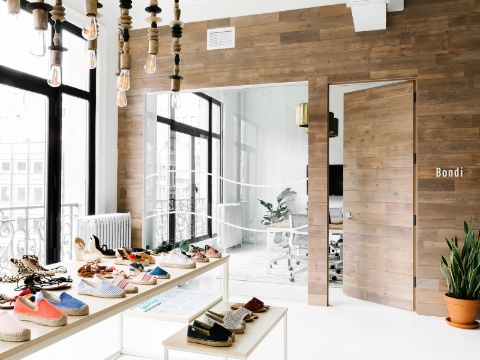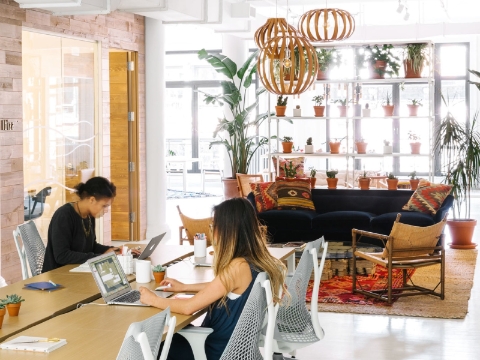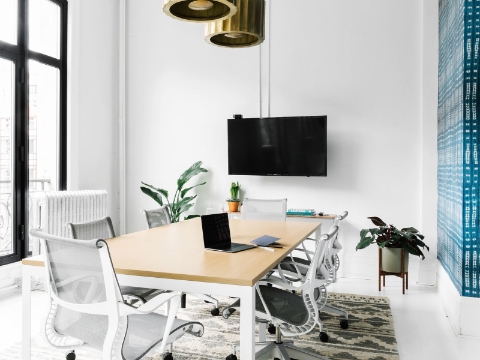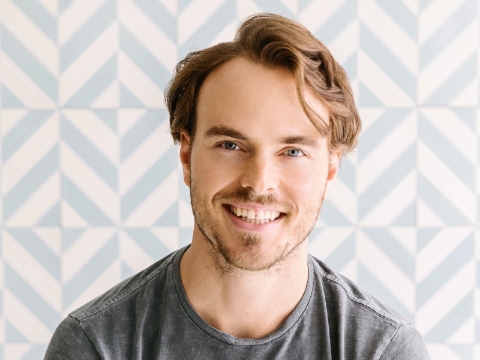Soludos
As a growing footwear company, Soludos needed an office that perfectly expresses the character of its brand, while nurturing creativity and efficiency for its people.
New York, New York, US
Download PDF (1.8 MB)
Espadrilles occupy a special place in the world of footwear. The artist Salvador Dali was famous for wearing these flat, rope-soled slippers that originated in Spain. Pablo Picasso and Grace Kelly were fans as well. So around 2006, when entrepreneur Nick Brown moved to New York City from London, he was shocked to discover that they hadn’t really made it across the Atlantic. That’s when he decided to set about rectifying the situation. Within five years, he founded Soludos.
Located in New York’s chic SoHo neighborhood, the company now makes highly sought-after contemporary versions of the classic Mediterranean footwear. “What's been amazing is this organic growth that we've had the past few years,” says Brown, whose first order—for 80 shoes—shipped with tags that he wrote up by hand. Fast forward two years and Soludos is selling more than 100 pairs a day online. High-end retailers in the United States and around the world carry the line—”We have a great business in Japan, the UK, and Australia,” Brown says—so not only has the company increased its staff, but it also works with a growing number of partners and customers. Unfortunately, however, Soludos’s workplace hadn’t kept up. “Our team was swelling, the walls were starting to close in a little bit,” Brown says. “We needed a new space that could help us with the needs of our business.”
It had been less than two years since the company moved into its previous location, and according to Robert Wright, marketing director for Soludos, the team worked tirelessly on evolving the business, but not enough on evolving the space to support its growth. “At that stage of the company, thinking about choosing the right desks and sourcing all of that isn't really at the top of your list,” Wright says.

Soludos worked with New York-based interior design consultants Homepolish in addition to Herman Miller to help the space reflect the personality of the Soludos brand. Homepolish focused primarily on the showroom area that greets visitors when they arrive.
Growing Pains
It soon became apparent, however, that failing to address the deficiencies of the company’s physical space was a critical misstep. As the pressure on the space grew, the clutter was hard to control. “There were just piles of boxes everywhere,” Brown says. “We couldn't find samples that we needed before rushing off to a (photo) shoot. We were constantly scrambling through everything.” The tight space had an open plan that was intended to facilitate collaboration, but it ended up being a challenge for teams as well as individuals. There was little privacy, which meant that people who worked on the phone a lot—on international sales or customer service—disturbed the whole office. And when employees wanted to touch base for a quick chat or a more formal conversation, no settings within the space supported such activities adequately.
The single meeting space had to serve many purposes, and it didn’t always live up to the challenge. “It was also a storage closet, and the place where we held a lot of interviews,” says marketing manager Lauren Tauflinger. “That made for a really fun time when boxes were collapsing on top of the people who we were trying to bring into the office.” The designers, who also used the space as a de-facto studio, found themselves constantly moving mood boards and prototypes into the crowded room to work on them, then out again to accommodate meetings or interviews.
But worst of all, the space simply didn’t embody the purpose and character of the Soludos brand. Brown travels the world for inspiration, and the company is connected to some of the biggest names in fashion. “For us to differentiate ourselves, to have that personality and to foster an emotional connection between customers and our product is the most important focus over the next few years,” he says. “There was a bit of a disconnect between our office and the brand that we aspire to be.”
Brown and his team turned to Herman Miller to find out how to bridge that gap. Soludos also brought in interior design company Homepolish to help add personalized details and informal spaces. The teams collaborated to create a workplace that supported both the day-to-day needs of individual employees and the long-term vision for the Soludos brand.
“Homepolish came in (and) really integrated with us and with the Herman Miller team, and brought a lot of personality from the brand to the space,” Wright says. This was particularly true in the living room areas and the showroom space. The result is a welcoming office that signals the creative energy of the company, or as Wright puts it, “It makes for an environment that's really much more us.”

Soludos worked with Homepolish to integrate vintage pieces into the mix of Herman Miller furniture used to outfit the space, creating settings such as this Cove (background), which has the look and feel of a Montauk beach house living room.

Natural light pours into a pair of Meeting Spaces, each outfitted with Layout Studio Tables and Setu Chairs, making them ideal for design reviews, when teams need to make decisions about colors and materials.
Making Creative Connections
At the outset, Herman Miller helped Soludos reevaluate how space might be optimized to both express the brand and support its people, as Brown says, “really trying to understand the challenges with the way that we used to work, and building a roadmap to efficiency within the office and organizational framework.” The first step was to understand the needs of each employee and the activities of the various teams. Then, Herman Miller worked with Soludos on creating a purposeful variety of settings that could address those needs and activities—a main working area or Hive, formal Meeting Spaces, and additional settings for more informal gatherings. Simultaneously, the adjacencies of these settings were planned to promote productive and efficient connections that could support the growth of the company.
For example, the workspaces in the back of the new office are organized into two pods, with the design team on one side and the production and finance teams on the other. A design island divides the space between them. This application gives each person the kind of dedicated space they lacked in the previous office, while also providing opportunities to interact with colleagues. “Those teams are constantly collaborating throughout the day,” Wright says. “Now, all they have to do is turn around, and they can talk and work together.”
In fact, everyone in the office can now collaborate with the designers as they put together the next collection of products. “We really wanted to build a beautiful space where they could pin inspiration images, swatches of fabric, things that were important to them,” Wright says. This kind of open workflow has a direct impact on how creative ideas get realized and are made available to customers. “We can turn around product much quicker than we've ever been able to before,” Brown adds.

Nick Brown is the founder and CEO of Soludos, a growing fashion brand with its headquarters in New York City’s SoHo neighborhood.
Expressing the Brand
Visitors to the space step off the elevators and encounter a display of Soludos products—the company’s first branded showroom. “It was a big priority, bringing sales in-house and having a showroom space that embodies the brand, that we can feel proud of,” Brown says. Located at the very front of the space, the showroom makes an immediate visual connection between the products on display and the design-savvy neighborhood outside.
For formal meetings, Herman Miller created two separate Meeting Spaces, outfitted with Layout Studio Tables and Sayl Chairs. Natural light floods into them during the day—an especially important aspect at design meetings, where the team has to make decisions about color swatches and materials. For gatherings where these Meeting Spaces might feel too formal, there are more informal settings with more of a living room feel.
The efficient workflows, the fluid design process, the ability to connect with customers at a deeper level, the touches of personality—all these things add up to an immersive environment where everyone connected with the brand enjoys spending time. “We have a lot of meetings here with partners of the brand,” Wright says. “When they come into the space, the first thing that almost everyone says is, ‘Wow! This space is so Soludos.’”